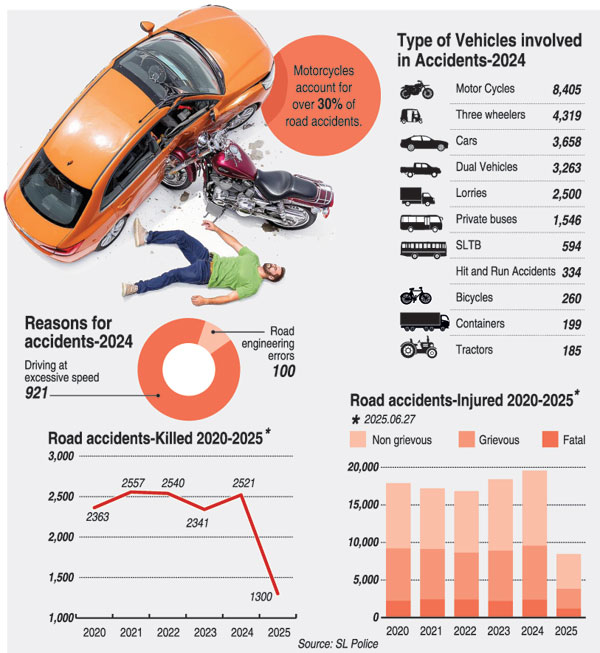News
Minor accidents fall by the wayside in Sri Lanka’s data collection
View(s):- Steep rise in fatalities and serious injuries seen, as worsening road safety crisis shows no sign of abating
By Dilushi Wijesinghe
While official statistics reveal a worrying rise in road traffic accidents, including fatal ones, across Sri Lanka, experts caution that these numbers don’t tell the full story. Many accidents, particularly minor ones, often go unreported, leading to discrepancies in data.
Although the Motor Traffic Act requires every accident to be reported to the police, in practice only major incidents make it into official records, said a senior official at the Colombo National Hospital, who did not wish to be named. This underreporting means the true scale of the problem is greater than reflected in current figures.
“Certain accidents go unreported, which may lead to discrepancies in the numbers, but we cannot confirm this with certainty. Only major accidents tend to get reported, even though, by law, every accident should be reported to the police,” he said.
There were also challenges of statistical consistency. “If we look at police statistics, the figures recorded at the end of a given year often differ from those reported for the same period when reviewed mid-year,” he said. “This shows how data can evolve, over time.”
There is a critical data gap, he pointed out: “Another area of concern is the lack of proper data on disabilities caused by road traffic accidents. We need to improve our data collection mechanisms to better capture this vital information.”
A senior official from a leading insurance company echoed this concern, telling the Sunday Times: “Despite this legal requirement, not all motorists follow through. In many cases, drivers either delay to report or avoid it altogether, especially in minor accidents. In some instances, the police themselves encourage drivers to settle the matter privately rather than pursue the lengthy legal process, to avoid delays and the additional costs involved.” He, too, did not wish to be named.
“If an accident happens today and the person dies a week later, it is still considered a fatal accident,” Traffic Management and Road Safety Division Director SSP Manoj Ranagala said. “In such cases, the driver involved is initially arrested and possibly released on bail. If the victim later dies, the driver is re-arrested and charged accordingly.”
“Many minor accidents are never reported to the police,” he admitted. “People often call their insurance provider directly and avoid making a police complaint unless there are serious injuries or significant vehicle damage.”
Following a directive given by Acting Inspector General of Police Priyantha Weerasuriya last month, the police have stepped up night-time patrols, SSP Ranagala said. “These raids focus on checking for drunk or drowsy drivers, especially among night bus operators,” he explained.
The worsening road safety crisis shows no sign of abating, however, with the latest statistics revealing a steep rise in fatalities and serious injuries, especially in the first quarter of 2025.
In 2024, road traffic fatalities surged to 2,521, up from 2,341 the previous year. Alarmingly, within the first three months of 2025 alone, 572 lives have already been lost to crashes.
Serious injuries also showed an increase, with 6,673 cases reported in 2023 rising to 7,157 in 2024. The first quarter of 2025 has already recorded 1,856 serious injuries. Minor injuries remain persistently high, with 9,996 reported in 2024, up from 9,492 the year before. The opening quarter of 2025 saw 2,580 such cases.
Property damage-only accidents saw a modest decline, from 6,498 cases in 2023 to 5,743 in 2024. The trend, however, remains significant, with 1,354 non-injury accidents already reported in the first quarter of this year.
In total, 25,299 road accidents were recorded in 2024, slightly up from 24,894 in 2023. The first quarter of 2025 logged 6,333 accidents.
A detailed breakdown of 2023 and 2024 accident data underscores motorcycles as the leading contributors to road traffic incidents. In 2023, of the 24,877 vehicle-related accidents reported, 8,270 involved motorcycles, resulting in 860 deaths, 2,713 serious injuries, and 3,560 minor injuries.

The trend worsened in 2024, with motorcycle accidents rising to 8,405. These led to 923 fatalities, 2,715 serious injuries, and 3,810 minor injuries—making motorcyclists the most at-risk road users.
Three-wheelers consistently ranked second. In 2023, 4,373 incidents involving three-wheelers were recorded, with 269 fatalities and over 3,000 injuries. In 2024, the figure slightly decreased to 4,319, but fatalities rose to 282. Injuries included 1,242 serious and 1,882 minor cases.
Cars were the third most involved category, with 3,658 accidents in 2024, 227 of which were fatal. Serious and minor injuries totalled over 2,100. Dual-purpose vehicles followed closely, recording 3,263 accidents, 280 fatalities, and more than 2,100 injuries in 2024. Lorries were linked to 2,500 accidents and accounted for 287 deaths.
Buses also featured prominently. Private buses were involved in 1,546 accidents (196 fatalities), while passenger buses recorded 594 cases (62 deaths).
Among less frequently involved categories, container trucks caused 199 accidents with 22 fatalities. Tractors accounted for 185 accidents and 28 deaths. Bicycle-related incidents rose from 237 in 2023 to 260 in 2024, with fatalities increasing from 33 to 43.
Preliminary data for the first quarter of 2025 confirms the persistence of these troubling trends. Motorcycles again led with 2,221 accidents, 192 of which were fatal. The quarter saw 756 serious injuries and 1,039 minor injuries involving motorcycles.
Lorries recorded 636 accidents, with 71 fatalities and 185 serious injuries. Three-wheelers were involved in 1,023 crashes (60 deaths), while cars logged 942 incidents (58 fatalities).
Private buses accounted for 389 accidents and 49 deaths. Passenger buses, though fewer in number, were involved in 144 cases resulting in 24 fatalities. Container trucks were linked to 41 accidents, with one fatality. Bicycles contributed to 66 incidents and eight deaths in the same period.
A deeper look at causative factors reveals that dangerous driving remains a leading contributor to Sri Lanka’s road safety woes. In 2023, 998 cases of reckless or aggressive driving were reported, declining marginally to 921 in 2024. However, 2025 has already seen 163 such incidents in the first quarter alone.
Poor road conditions also featured in the data, with engineering or maintenance-related issues causing 21 accidents in 2023. That number jumped to 100 in 2024 before dropping to 11 in early 2025. While this decline is welcome, experts warn that even sporadic lapses in road infrastructure can have deadly consequences.
Cumulatively, 2,214 incidents from 2023 to early 2025 have been directly linked to driver behaviour and poor road conditions.
He stressed the need for a more targeted and collective approach to prevent accidents from taking place. “Despite ongoing efforts, we have not been able to reduce road traffic accidents, with at least 6 to 8 people dying every single day. Preventive measures must take a targeted approach, focusing on vulnerable groups such as motorcyclists and pedestrians. Everyone has to take responsibility — from policymakers to individuals on the road.”
“We need both policy-level and behavioral changes. Improving public transport is also critical. When we look at the trends, we see the same patterns continuing. The same culprits — motorcycles and pedestrians — remain at the center of most accidents. Our roads are good, but the accidents continue at the same rate” he said.
“In the end, each and every individual must take responsibility to help prevent road traffic accidents.”
| Safety on the roads set to take a new turn With road accidents continuing to claim thousands of lives each year, Sri Lanka is making a decisive policy shift through the launch of the ‘Go Safe – Road Safety Action Plan 2025–2026’. This operational framework by the Ministry of Transport and Highways introduces a focused and coordinated approach to reducing traffic fatalities and injuries, while building a culture of safety across the country’s transport network. The plan is grounded in three principles. First is the adoption of the globally recognised five pillars of road safety which include road safety management, safer roads and mobility, safer vehicles, safer road users and post-crash response. Second is the implementation of a clearly defined set of planned processes (defining how change is planned, implemented, and monitored). Third is the execution of these processes by accountable individuals and institutions. These principles aim to shift the country’s approach from fragmented and reactive efforts to a proactive, system-based and outcome-driven model of road safety governance. Between 2020 and 2024, the country recorded 118,697 road accidents resulting in 12,322 deaths. That averages to about 2,464 fatalities each year. While there has been a marginal decline in the fatality rate, from 13.6 to 11.2 deaths per 100,000 population, the number still exceeds the globally recommended benchmark of fewer than 10 deaths per 100,000. To meet this target, Sri Lanka must reduce road deaths by approximately 267 each year. Motor bicycles are the most frequently involved vehicles in accidents, accounting for 35 percent of incidents. Motor cars, dual-purpose vehicles and lorries together contribute to 37 percent. Private buses account for six percent of traffic accidents, while CTB buses make up two percent. Although these percentages seem small, the impact of bus-related accidents is considered disproportionately high due to the larger number of passengers they carry. The action plan highlights that motorcyclists make up 34 percent of all traffic fatalities. When combined with pedestrian fatalities, the figure rises to 63 percent. This indicates that nearly two-thirds of road accident victims in Sri Lanka are among the most vulnerable road users, and that the country’s road safety interventions must prioritise their protection. Bus-related offences are described as “a complex and multi-dimensional crisis.” An average of 11,426 traffic law violations involving buses are recorded annually, accounting for 74 percent of such offences. Speeding makes up 11 percent, reckless driving nine percent, and drug-impaired driving two percent. Between 2020 and 2024, bus-related offences led to 354 fatal crashes and 356 deaths. However, the issue is not limited to driver behaviour alone. The plan points out that poor infrastructure design, weak enforcement, low public awareness and a shift from public to private transport also contribute to the crisis. The action plan outlines 94 targeted actions to be implemented between 2025 and 2026. These include strengthening legislation, updating road safety policies, launching a centralised crash data system, and increasing the use of automated enforcement tools. Other initiatives involve enhanced driver training, introduction of GPS monitoring systems, improved post-crash response, and a national road safety audit programme. Part of the strategy is focused on improving the safety and quality of the country’s road infrastructure. This includes identifying accident blackspots, increasing pedestrian crossings, installing speed limit signs and implementing better lighting at high-risk areas such as school zones and railway crossings. It also calls for the deployment of AI-powered cameras in buses and the use of intelligent transport technologies to detect driver fatigue or distracted driving. The plan also proposes new measures for vehicle fitness, including stricter inspections, mandatory seatbelt use for all passengers on expressways, and updated standards for bus fleets. For road users, there are plans to modernise driving school curricula, introduce simulation-based training, and recognise safe drivers through awards and incentives. Post-crash response efforts are also being strengthened with enhanced triage protocols, trauma care training for emergency teams and structured support for victims and families. | |
The best way to say that you found the home of your dreams is by finding it on Hitad.lk. We have listings for apartments for sale or rent in Sri Lanka, no matter what locale you're looking for! Whether you live in Colombo, Galle, Kandy, Matara, Jaffna and more - we've got them all!

